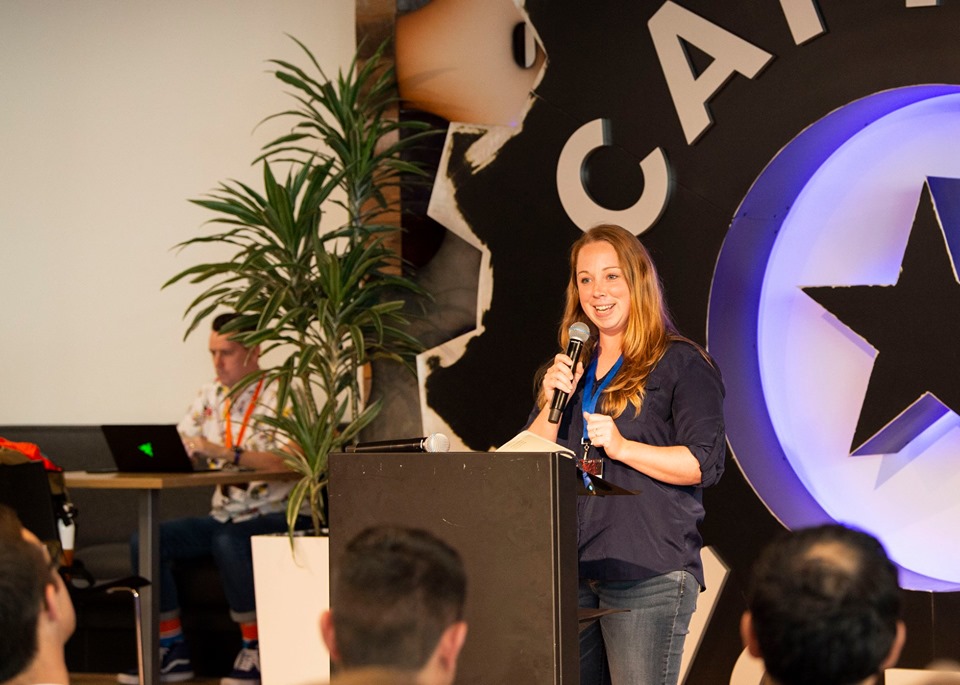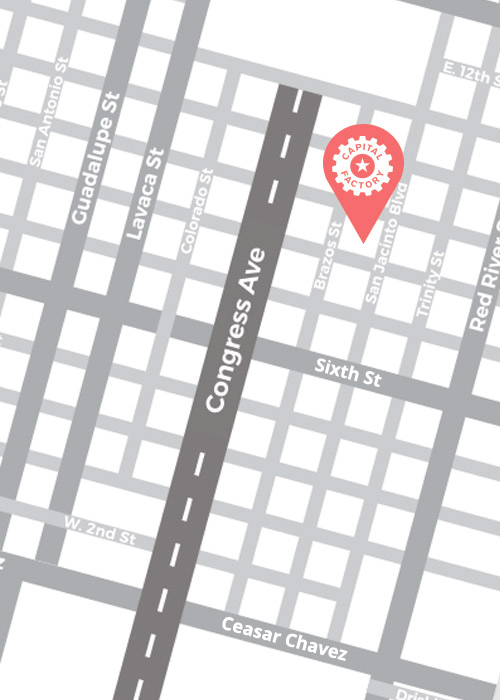THE CENTER OF GRAVITY FOR ENTREPRENEURS IN TEXAS


On August 14-15, the Air Force, through AFWERX, hosted a two-day Spark Collider event at Capital Factory to bring newly awarded 19.2 SBIR Phase I companies together with relevant Air Force and venture capital stakeholders. AFWERX, who works out of Capital Factory’s Center for Defense Innovation, serves as a channel through which entrepreneurs can access the necessary resources to make their ideas a reality within the U.S. Air Force.
What does SBIR Phase I mean, exactly? The highly competitive Small Business Innovation Research (SBIR) program was created by Congress back in 1982 to fund and encourage domestic small businesses to engage in Federal Research/Research and Development (R/R&D). At Spark Collider, there were 100 companies present that received an initial award from the Department of Defense (DoD) — which denotes them as Phase 1 SBIR Awardees. There are 3 Phases total, and each results in an increased monetary award as well as varying development pipelines.
“The intent of Spark Collider is to help companies match their solutions with Air Force customers who can use them, and in that regard it was a tremendous success. We can and will make it better by working more deliberately to match problems and solutions, as well as bringing in commercial customers and investors. This event will only get better and better for the companies participating, AFWERX and our nation’s warriors.”
—Kevin Landtroop, Defense Venture Partner at Capital Factory
Meet The Dean of Innovation
On Wednesday morning, Capital Factory had a full house of startups, government (and non-government) officials, Air Force and venture capital attendees gathered and eager to discuss the problems at hand that need innovative solutions. Jeff Degraff took to the stage and wasted no time in jump-starting the conversation— “What does your innovation kill?”
Jeff is a well established advisor to Fortune 500 companies, a top innovation speaker, a business professor at the Ross School of Business and a bestselling author. One of the tricky aspects about innovation, Jeff explained, is that if you get stuck in the planning cycle— your innovation goes sour. Innovation unfortunately becomes a commodity very quickly.
He provided an example from his own life to drive his next topic, which involves the balance of life and business: “The more you get accomplished, the more your life will be managed.” The more successful Jeff became, the more assistance he needed to organize his day-to-day schedule. When your life is choreographed out, you want to then grow out of that cycle and do something different. Since most of our lives are governed by maintenance, innovation becomes a form of deviating from the norm and creating constructive conflict.
Amazing keynote from @JeffDeGraff at the @AFWERX collider event this morning. Really impressive & demonstrates how serious the @usairforce is about fostering true #innovation. pic.twitter.com/CuqZO3I1Xr
— Blueforce (@blueforcedev) August 14, 2019
The Symbiosis of Startups, Government & Venture Capital
After Jeff’s keynote address, registrants had several breakout sessions to choose from including “The DoD Innovation Ecosystem and AFWERX” and “SBIR 101 for Companies: Phase I Roadmap for New SBIR Awardees”. These breakouts allowed attendees to become more acquainted with aspects of AFWERX or the startup ecosystem that they weren’t familiar with, as well as gathering together to begin tackling Air Force problems head-on.
The closing panel on Day 1 felt like the start of a witty punchline, “A startup founder, a government official, and a venture capitalist walk into a room…”— what ensued was an incredibly insightful exchange about the reality of working with each other. Moderator Kevin Landtroop was joined by Tony Perez, Director of Spark for AFWERX, Matthew Scott, Director of AFWERX Austin, Jason Ballard, CEO and co-founder at ICON3D, and Larsen Jensen, co-founder of Harpoon.
Jason made a familiar point about how hard it is to find customers when you’re left to your own devices. He recalls making a trip to the Pentagon and feeling a bit lost and out of place. At the end of the day, there’s a mutual benefit to having startups in the “uptight” DoD ecosystem. Larsen added that his goal is to be able to identify a company that has a solid large scale commercial enterprise go-to-market strategy, while also showing potential for opportunity in the federal space. From there, it’s a matter of informing companies that there are new ways to work with defense customers through connecting with Tony at Spark or through SBIR programs, for example.
Right now, speakers from #AFWERX, @ICON3DTech, Harpoon and @CapitalFactory are discussing the symbiosis of #startups, government, and #venturecapital during the @usairforce #SparkCollider event. Watch it live: https://t.co/1QrhaD1ftL pic.twitter.com/Ai7krnNqAx
— AFWERX (@AFWERX) August 14, 2019
Fireside Chat
The final day of Spark Collider began with some encouraging words from Dr. Will Roper, Assistant Secretary of the U.S. Air Force for Acquisition, Technology and Logistics.
Day 2 of the #SparkCollider just kicked off with an appearance from Dr. Will Roper, Assistant Secretary of the @usairforce for Acquisition, Technology and Logistics. Can't wait to see what the rest of the day brings! Watch it live: https://t.co/1QrhaD1ftL pic.twitter.com/OorV0qXosp
— AFWERX (@AFWERX) August 15, 2019
Immediately following Dr. Roper’s welcome, the event’s second keynote was set in motion with a fireside chat featuring guests Peter Newell, CEO at BMNT, and Teresa Smetzer, CEO at Smetzer Associates, moderated by Tony Perez. When asked about their experience with the government’s approach to solving problems versus how we should be handling it, Teresa stated that the failure to deliver is most often due to too much focus on the technology. You should start with a mission and a clear problem— it’s hard to transition into something meaningful without those present.
Peter concurred, and also noted that everything moves forward when companies start the conversation with a deep understanding of the problem they’re trying to solve. Another shared conclusion was that the government is very programmatic, so if you haven’t been involved from the beginning it’s hard to get them on board with the innovative concepts you’re offering. It’s critical to understand the systems and programs in place when trying to work with the government.
Center stage with the @BMNT_inc & @AFWERX team @CapitalFactory helping @usairforce find solutions to real problems pic.twitter.com/M7xzCLsfdi
— Pete Newell (@PeterANewell) August 16, 2019
So You Want To Work With Startups?
During both days of Spark Collider, SBIR Phase I awardees had the chance to present their startup through pitch showcases and exhibit tables. This layout allowed founders to interact directly with stakeholders and potentially draft memorandum of understanding (MOU) commitments right then and there. With everyone out on the floor together, attendees found it considerably more helpful than having to go out and find customers one-on-one. At Spark Collider, the floor is open for introductions and discussions.
Thank you @AFWERX for the opportunity to pitch our @AF_SBIR_STTR Phase I Select at today's #SparkCollider event! pic.twitter.com/aXcOX6Vf2J
— SaltyCloud (@saltycloudpbc) August 14, 2019
Gordon Daugherty, President at Capital Factory, offered stakeholders a better understanding of the startup operating system as well as some best practices for how to work with startups effectively. He started off by explaining that startups don’t all necessarily think or act alike. They get down their product path quickly, don’t always come equipped with a grand plan, and are putting the pieces together as they go to stay agile and innovative. Although this flow may not be familiar or ideal to some— it does go to show that startup founders are both incredibly resilient and creative problem solvers.
Whether you come from a government, corporate or venture capital background and you’re concerned about working with startups— it’s essential to acknowledge that both sides are tough to work with, but it’s worth it in the end. Gordon advised attendees to work together and integrate as best as possible.
Bringing Tomorrow’s Tools To The Warfighter Today
Before Day 2 came to an official close, there were five Air Force problem briefs presented to a panel of judges to receive feedback and, potentially, a monetary award to go towards sponsoring a solution. We got to hear from an Air Force technician, Airmen from the 19th Air Force, an Airman from the 353rd Special Operations Group, a captain from the 377th Air Base Wing and the chief of 673rd Wing Weapons and Tactics from Joint Base Elmendorf-Richardson. The issues primarily addressed AI automated systems, data aggregation, communication and streamlining pilot training. After their presentations, there was enthusiastic interaction from the crowd; offering plenty of commentary and recommendations on how to approach the problems.
Joshua Baer, CEO and founder of Capital Factory, added a few words to close out the Spark Collider by thanking all of the companies and DoD members for their involvement and for making the event such a huge success. He also touched on the impact of our unprecedented Center for Defense Innovation, and how impressed he is with AFWERX’s ability to keep connecting influential and interesting people in the defense technology community.
“The Spark initiative helps Airman create pathways to bring real solutions to their day-to-day pain points. Here at the Spark Collider, Airmen get to have honest conversations with nontraditional vendors who are contract-ready and whose solutions can be executed rapidly. Through a team-of-teams approach and the efforts of multiple program offices, Air Force Acquisitions, the Air Force Small Business Innovation Research program, various Major Commands, and AFWERX, we are bringing tomorrow’s tools to the Warfighter today. Airmen of all ranks are here to find the solutions that work for them which speaks volumes about the trust local leaders place in their people to shape the future of the Air Force.”
—Tony Perez, Director of Spark for AFWERX
This Spark Collider is the first of many events that Capital Factory looks forward to being involved with in the future. It was a spectacular sight to see all the SBIR companies interacting with the DoD in such a transparent and candid manner. As we heard from multiple speakers— innovation requires collaboration, even if bumps in the road arise from conflicting ideas or established systems.

Comments
Categories
Tags
Questions?
By Appointment Only
Our doors are open! Reach out to Members@CapitalFactory.com to book your private, in-person membership tour.
